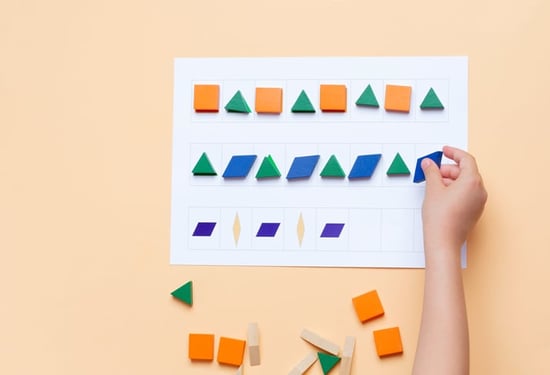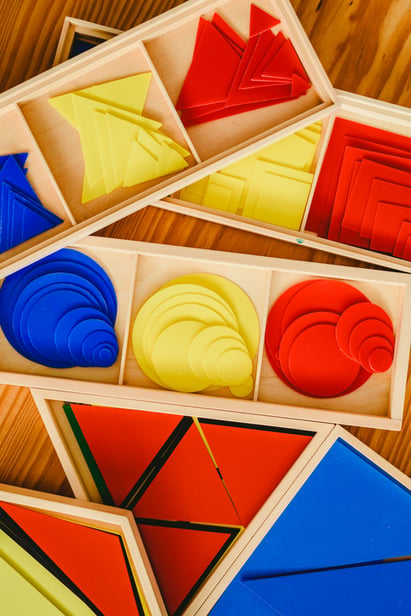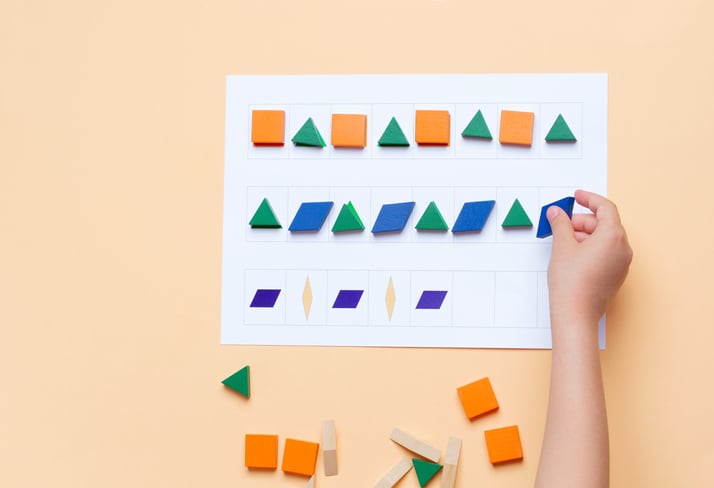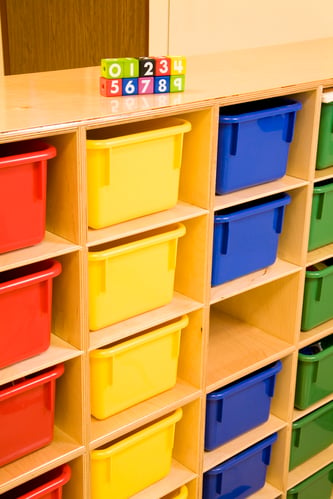Activities for Teaching Color Patterns
-
Ice-Cream Patterns
 If your students are fans of ice cream, this activity will excite them. You can begin by drawing an ice cream cone on a piece of cardboard. After doing so, create small circles in two different colors and stick each colored circle on a craft stick. These small circles represent scoops of ice cream. Students who are new to patterning can extend the AB pattern that you have created by continuing to alternate two colors. If your students are more advanced, offer them a challenge and have them create ABC patterns or their own desired patterns. The action of squeezing the craft stick supports student fine motor skills – a domain autistic students struggle with.
If your students are fans of ice cream, this activity will excite them. You can begin by drawing an ice cream cone on a piece of cardboard. After doing so, create small circles in two different colors and stick each colored circle on a craft stick. These small circles represent scoops of ice cream. Students who are new to patterning can extend the AB pattern that you have created by continuing to alternate two colors. If your students are more advanced, offer them a challenge and have them create ABC patterns or their own desired patterns. The action of squeezing the craft stick supports student fine motor skills – a domain autistic students struggle with.
-
Pattern Pathways
Kinesthetic learners will welcome this activity. Introduce this activity by taping colored construction paper to the ground to form a pattern. You should have extra copies of each colored paper. Encourage your students to jump from one color to the next in the pattern path. When they have reached the end, ask the student what color should come next. If they select the correct color, place it on the ground and let them continue jumping. To entice students, ask them for suggestions on the type of path they want to create and the colors they wish to use.
-
String Me Up
Enjoy a party in your mouth while learning about patterns in this activity. Have your students grab a handful of fruit loops and a string. Advanced students can create their patterns while those new to patterns can be given opportunities to extend patterns that you have created in advance. If you have students with food allergies, go ahead and substitute the fruit loops with the Stringing Bead Kit
- Paint a Pattern
Teachers and parents interested in integrating art into numeracy activities can opt for this activity. Give each student a paintbrush and palette filled with their favorite colors. Once all materials are ready, tell each student to create their own ABC patterns. To accommodate students with differing abilities, you can create a pattern and scaffold their learning by asking them what comes next. Autistic students can feel overwhelmed by bright visual stimuli. If you want to help them stay calm, some students may prefer cool colors such as green, purple, and pale pink.
 Examples of ABA patterns using manipulatives
Examples of ABA patterns using manipulatives
Activities for Teaching Shape Patterns
-
Cut and Arrange
This activity is a test of your students’ fine motor skills and understanding of shapes. Give each student a pair of scissors and encourage them to cut out their preferred shapes, for example, circles, squares, and rectangles. After they have prepared their shapes, have them arrange them in an ABC pattern. Depending on your student's abilities, you can increase or decrease the difficulty of this activity.
-
Line-Up!
Math activities can be fun and interactive too. This activity showcases students’ understanding of patterns and their teamwork. Print some shapes out and distribute a shape to each student. Inform your students they must arrange themselves in an AB, ABC, or ABCD pattern based on the shape they are holding. To support students who need additional support, you can create the pattern and have them extend it. This activity can help you assess which students are weaker or stronger in patterns. You can promote class partnership by encouraging stronger students to guide the weaker ones such that the pattern is extended correctly.
-
Pattern Search
You will need butcher paper and shape stamps for this activity. Begin this activity by having students stamp the shapes randomly all over their butcher paper. Using another butcher paper, have each student create their pattern using the shape stamps. Teachers can assist weaker students by creating a pattern with them. Next, ask each student to use a marker to connect the stamped shapes in the first piece of butcher paper in the same order as the pattern they created on their own. You can turn this activity up a notch by challenging students to find and connect a 3 or 4-shape pattern.

Activities for Teaching Complex Patterns
-
Pattern Card Game
This challenging activity reinforces the pattern concepts students learned previously. Using patterned wrapping paper or construction paper, create a deck of cards. Then, trace 10 to 15 of each color or pattern on white index cards. Next, glue or laminate the white index card and colored/patterned paper together while ensuring the cards are blank on one side. Once this step is completed, shuffle the cards with the blank side up to form a deck. Draw 3 to 4 cards to form a pattern and distribute 5 cards to each player. Take turns extending the pattern with the cards in your hand. If none of your cards fit the pattern, draw from the remaining cards until you have the right card. Continue this game until all cards have been drawn or until someone runs out of cards.
-
Groove Along
If you are looking for an activity to cater to your students’ bursting energy levels, this will suit you. Grab all the pots, pans, drums, and other musical instruments and lay them on the ground. You will make a tune with the instruments, and your students will need to extend the pattern/tune with their equipment. You can also ask students to name the pattern/tune you created.
-
Move Along
Get creative and start moving with this activity. Begin by taking down students’ suggestions about the movements they want to enact. Some examples are hopping, twirling, nodding, and clapping. Then, have them refer to the movements to form a pattern. You can demonstrate by doing a pattern – twirl, nod, twirl – and then have your students extend it. Once your students show confidence, challenge them by asking them to form longer and more challenging patterns with their peers.
If you run out of ideas to impart the concept of patterns to your students, refer to any of the activities above. Teachers and parents with no time to prepare can dip into the Language Builder: ARIS curriculum to retrieve a useful collection of manipulatives to teach patterns to autistic students. Besides the colorful wooden blocks, there are also everyday objects, foods, and animal’ manipulatives that will appeal to students’ interests. With so many manipulatives around, there is no need to worry about the lack of materials to enhance your students’ learning.




 One helpful resource you want to put in class to help you meet students’ needs is our comprehensive, early autism curriculum kit - The
One helpful resource you want to put in class to help you meet students’ needs is our comprehensive, early autism curriculum kit - The 

